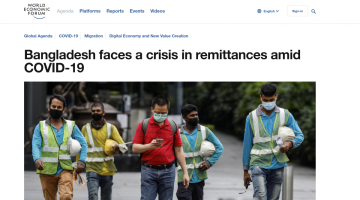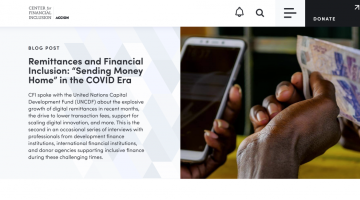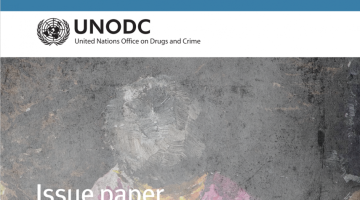Library
- Resource - Other
The coronavirus pandemic has caused remittances back into Senegal to dry up as COVID-19 has taken grip and lockdown measures have affected the migrant workers who normally send the money from mostly European countries such as France, Italy and Spain.
SourceUN Capital Development Fund (UNCDF)GCM Objectives
- Resource - Other
Remittances represent more than a quarter of Nepal’s economic output; The pandemic means migrant workers have swapped the risk of death or injury at work with the reality of poverty and homelessness; Financing a shift from subsistence to commercial farming could help prevent food shortages and...
SourceWorld Economic ForumGCM Objectives
- Resource - Other
The coronavirus pandemic highlights the need for better cooperation over migration; Bangladesh has offered incentives to encourage expatriate workers to send their money through legal channels; Public bodies and remittance services providers must improve access to digital solutions.
SourceWorld Economic ForumGCM Objectives
- Resource - Other
The Democratic Republic of the Congo (DRC) is home to 10 percent of the world’s entire population of internally displaced people – the largest such situation in Africa, with an estimated 5 million people. The DRC also hosts more than half a million refugees and asylum seekers from neighboring...
SourceFinDev GatewayGCM Objectives
- Resource - Other
The COVID-19 pandemic has seriously disrupted African economies, including the vital flow of remittances. To respond to these worrying developments, the Ethiopian government is pursuing policy reforms to stabilize its economy as well as formalize remittances to keep them flowing for its vulnerable...
SourceFinDev Gateway, UN Capital Development Fund (UNCDF)GCM Objectives
- Resource - Other
The socio-economic importance of the money sent home by Myanmar’s migrants working abroad cannot be overstated. Remittances serve to diversify and smoothen household income and are particularly critical to strengthening the financial resilience of women and rural populations. The pandemic of...
SourceUN Capital Development Fund (UNCDF)GCM Objectives
- Resource - Other
Before the COVID-19 pandemic struck, many migrants were already part of marginalized and vulnerable groups experiencing economic hardships in their countries of origin and host communities. Lockdowns and business closures have exacerbated the precarious nature of their livelihoods.
SourceCenter for Financial Inclusion (CFI)
- Resource - Other
This issue brief provides an explanation of the three specific targets of the Sustainable Developments Goals (SDGs) that mention trafficking in persons as well as several other SDGs relevant to addressing trafficking in persons, and makes recommendations about what States can do to achieve them by...
SourceInter-Agency Coordination Group against Trafficking in PersonsGCM Objectives
- Resource - Other
This issue brief sheds lights on how trafficking in children differs from trafficking in adults, gives a data snapshot on what the scale of trafficking in children is, talks about child-specific drivers and challenges and gives recommendations.
SourceInter-Agency Coordination Group against Trafficking in Persons
- Resource - Other
There is a growing body of evidence demonstrating that humanitarian crises, such as armed conflicts, natural disasters, and protracted unrest, can lead to an increase in trafficking in persons. This issue brief explains what makes crisis-affected communities and individuals vulnerable to trafficking...
SourceInter-Agency Coordination Group against Trafficking in Persons
- Resource - Other
This issue brief clarifies the relationship between refugee status and trafficking in persons across a number of situations and provides recommendations on what States can do to ensure that victims of trafficking have access to international protection as refugees where they need it.
SourceInter-Agency Coordination Group against Trafficking in Persons
- Resource - Other
This paper seeks to construct a common framework for aligning goals, defining and assessing progress, and building a robust and shared evidence- base of effective anti-trafficking programmes and practices. It suggests a road map for capturing and using knowledge accumulated in the sector and beyond...
SourceInter-Agency Coordination Group against Trafficking in PersonsGCM Objectives
- Resource - Other
This issue paper highlights that access to remedies for trafficking victims should be a core component of efforts to address human trafficking and provides illustrative examples of effective remedies and limitations that currently exist in different jurisdictions. Effective access to remedies is...
SourceInter-Agency Coordination Group against Trafficking in PersonsGCM Objectives
- Resource - Other
The purpose of this issue paper is to clarify the key concept of exploitation in the definition of trafficking in persons contained in Article 3 of the Trafficking in Persons Protocol.
SourceUnited Nations Office on Drugs and Crime (UNODC)
- Resource - Other
The paper characterizes key related elements of the anti-trafficking response, highlights assumed features that still require development and recommends a number of prioritized actions to bring to bear provisions and legal obligations from different bodies of law and legal instruments that are...
SourceInter-Agency Coordination Group against Trafficking in PersonsGCM Objectives
- Resource - Other
The present issue paper discusses certain questions that remained about certain aspects of the definition of trafficking in persons as defined in the Trafficking Protocol – most particularly those aspects that are not elsewhere defined in international law or commonly known to the world’s major...
SourceUnited Nations Office on Drugs and Crime (UNODC)GCM Objectives
- Resource - Other
The present issue paper discusses certain questions that remained about certain aspects of the definition of trafficking in persons as defined in the Trafficking Protocol – most particularly those aspects that are not elsewhere defined in international law or commonly known to the world’s major...
SourceUnited Nations Office on Drugs and Crime (UNODC)
- Resource - Other
The Case Digest has analysed 135 cases from 31 jurisdictions. The Case Digest presents evidential issues and patterns and describes how different jurisdictions addressed these. It recognizes that there may not be one answer to a question or issue, but that there is an added value in presenting a...
SourceUnited Nations Office on Drugs and Crime (UNODC)GCM Objectives
- Resource - Other
The Issue Paper issues conceptual clarity and interpretation of various terms in the international definition of Trafficking in Persons as defined in Article 3 of the Protocol to Prevent, Suppress and Punish Trafficking in Persons, Especially Women and Children, in addition to providing the guiding...
SourceUnited Nations Office on Drugs and Crime (UNODC)GCM Objectives
- Resource - OtherSkills Matching and Labour Mobility: A Policy Position Paper of the ASEAN Confederation of Employers
As part of the employers’ component of the ASEAN Triangle project an Action Plan to fully engaging employers’ organizations in ASEAN processes was developed with the ASEAN Confederation of Employers (ACE.) Five priority areas namely: skills matching and mobility, occupational safety and health...
SourceASEAN Confederation of Employers
Pagination
About the Migration Network Hub
What is the Migration Network Hub?
The Hub is a virtual “meeting space” where governments, stakeholders and experts can access and share migration-related information and services. It provides curated content, analysis and information on a variety of topics.
The Hub aims to support UN Member States in the implementation, follow-up and review of the Global Compact for Migration by serving as a repository of existing evidence, practices and initiatives, and facilitating access to knowledge sharing via online discussions, an expert database and demand-driven, tailor-made solutions (launching in 2021).
Submit your content
What content is displayed in the Hub?
The Hub aims to help you find information on migration, ranging from policy briefs and journal articles, existing portals and platforms and what they offer, to infographics and videos. The different types of resources submitted by users undergo peer review by a panel of experts from within the UN and beyond, before being approved for inclusion in the Hub. To provide guidance to users based on findings of the needs assessment, the content is ordered so that more comprehensive and global resources are shown before more specific and regional ones. Know a great resource? Please submit using the links above and your suggestion will be reviewed. Please see the draft criteria for existing practices here.
Apply to join the Peer Review Roster
Content submitted to the Migration Network Hub is first peer reviewed by experts in the field from both the UN and beyond. Applications are welcomed to join the roster on an ongoing basis. Learn more here.
Contact us
We welcome your feedback and suggestions, please contact us
*References to Kosovo shall be understood to be in the context of United Nations Security Council resolution 1244 (1999).
Newsletter
Subscribe to our newsletter.